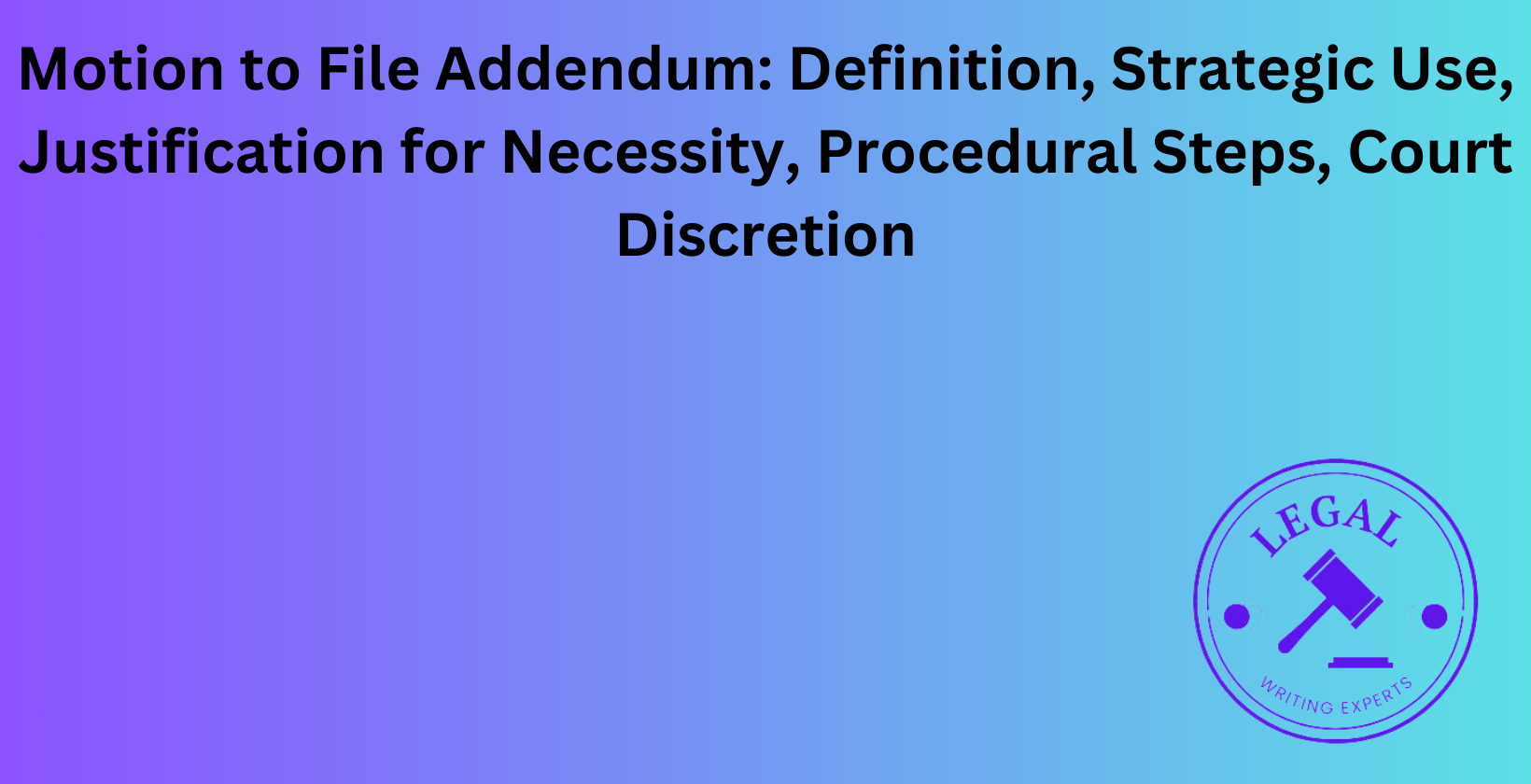Motion to File Addendum
Written by
Jessica E
October 24, 2024 · 8 min read

A motion to file addendum is a crucial legal tool used to supplement or modify existing legal documents in ongoing court proceedings. This article explores the definition, strategic use, justification for necessity, procedural steps, and court discretion involved in filing such motions. Understanding these aspects is essential for legal professionals, litigants, and anyone involved in the legal process to effectively utilize this procedural mechanism.
What Is a Motion to File Addendum?
A motion to file addendum is a formal request submitted to the court seeking permission to add supplementary information or documents to an existing legal filing. This legal document allows parties to include additional relevant information, correct errors, or address new developments that have arisen since the original filing. The addendum serves as an attachment to the original document, providing clarity, context, or updated information to support the case.
How to Write a Motion to File Addendum?
Writing a motion to file addendum requires careful attention to detail and adherence to legal formatting standards. The motion should clearly state the purpose of the addendum, explain its relevance to the case, and provide justification for its inclusion. Legal writers must use concise language, cite relevant laws or precedents, and organize the content logically. The motion should include a brief introduction, a statement of facts, legal arguments supporting the need for the addendum, and a conclusion requesting the court’s permission to file the addendum.
Where Can I Hire a Legal Writer to Draft a Motion to File Addendum?
Legal writers specializing in drafting motions to file addendum can be found through Legal Writing Experts channel. Legal Writing Experts often employ in-house legal writers or contract with freelance legal professionals. Legal Writing Experts is an online platform dedicated to legal services providing access to experienced legal writers who can craft well-structured motions. It offers writers that have expertise in drafting complex legal documents, including motions to file addendum. When hiring a legal writer, consider their experience, expertise in the specific area of law, and familiarity with local court procedures.
How to File a Motion to File Addendum?
Filing a motion to file addendum involves several steps. First, prepare the motion document according to court rules and formatting guidelines. Next, gather any supporting documents or exhibits that will be included with the addendum. File the motion with the court clerk, ensuring all required copies are submitted. Serve the motion on all parties involved in the case, following proper service procedures. Pay any necessary filing fees and obtain a hearing date if required by the court. Familiarize yourself with local court rules and procedures, as they may vary by jurisdiction.
What Is the Difference Between an Amendment and an Addendum in Legal Documents?
An amendment and an addendum serve different purposes in legal documents. An amendment modifies or alters the original document, replacing specific sections or clauses. It becomes an integral part of the original document, changing its content directly. An addendum, on the other hand, supplements the original document without altering its existing content. It adds new information, clarifications, or updates as a separate attachment to the original document. Amendments typically require more formal procedures and may have stricter requirements for approval compared to addendums.
When Should a Motion to File Addendum Be Used?
A motion to file addendum should be used when new information or circumstances arise that are relevant to the case but were not included in the original filing. It is appropriate when correcting minor errors, providing additional supporting evidence, or addressing recent developments that impact the case. The motion is particularly useful when time constraints or procedural rules prevent the filing of a completely new document. Courts generally allow addendums when the additional information is material to the case and its inclusion serves the interests of justice.
How Does a Court Decide on a Motion to File Addendum?
Courts consider several factors when deciding on a motion to file addendum. The relevance and materiality of the proposed addendum to the case are primary considerations. Judges evaluate whether the additional information will assist in reaching a fair and just decision. The timeliness of the motion is crucial, as courts may be less inclined to grant motions filed late in the proceedings. The potential impact on other parties and the overall case schedule is weighed. Courts balance the need for complete information against the principles of fairness and efficient case management.
What Are the Strategic Benefits of Filing a Motion to File Addendum?
Filing a motion to file addendum offers several strategic benefits in legal proceedings. It allows parties to introduce new evidence or arguments that strengthen their case without the need for a complete refiling. The addendum can address weaknesses in the original filing, respond to opposing arguments, or adapt to changing circumstances. It demonstrates diligence and attention to detail, potentially improving credibility with the court. Strategically timed addendums can influence the direction of the case or prompt settlement discussions. However, the benefits must be weighed against potential drawbacks, such as delays or increased scrutiny from opposing parties.
How Long Does It Take to Process a Motion to File Addendum?
The processing time for a motion to file addendum varies depending on the court’s caseload and the complexity of the motion. Generally, courts aim to process such motions within 2 to 4 weeks. Factors affecting processing time include the nature of the case, the volume of additional information, and any objections from opposing parties. Some courts may expedite the process if the motion is time-sensitive or critical to ongoing proceedings. Parties should consult local court rules or contact the court clerk for specific timelines in their jurisdiction.
Can a Motion to File Addendum Be Rejected by the Court?
Yes, a motion to file addendum can be rejected by the court. Courts may deny the motion if the proposed addendum is irrelevant, untimely, or prejudicial to other parties. Rejection can occur if the addendum introduces entirely new claims or defenses that should have been included in the original filing. Courts may deny motions that appear to be attempts to circumvent filing deadlines or procedural rules. To minimize the risk of rejection, ensure the motion clearly demonstrates the necessity and relevance of the addendum to the case at hand.
What Are the Common Mistakes When Filing a Motion to File Addendum?
Common mistakes when filing a motion to file addendum include failing to clearly explain the necessity of the addendum, submitting irrelevant or excessive information, and neglecting to follow proper formatting and citation requirements. Parties sometimes err by attempting to introduce entirely new arguments or claims that should have been part of the original filing. Failing to serve all parties with the motion or missing filing deadlines are procedural mistakes that can lead to rejection. To avoid these errors, carefully review court rules, seek guidance from experienced legal professionals, and ensure the addendum directly addresses the case’s specific needs.
Is It Necessary to Have Legal Representation for a Motion to File Addendum?
While legal representation is not strictly necessary for filing a motion to file addendum, it is highly recommended. Legal professionals possess the expertise to craft compelling arguments, navigate complex procedural rules, and anticipate potential objections. They can ensure the motion and addendum comply with court requirements and effectively support the case strategy. Self-represented litigants may face challenges in properly formatting the motion, citing relevant legal authorities, and articulating the necessity of the addendum. The complexity of the case and the potential impact of the addendum on the proceedings should guide the decision to seek legal representation.
What Are the Costs Associated with Filing a Motion to File Addendum?
The costs associated with filing a motion to file addendum vary depending on several factors. Court filing fees typically range from $50 to $200, depending on the jurisdiction and type of case. If legal representation is employed, attorney fees for drafting and filing the motion can range from $500 to $2,000 or more, based on the complexity of the case and the attorney’s experience. Additional costs may include document preparation, copying, and service of process fees. Some courts offer fee waivers for eligible individuals facing financial hardship. It’s advisable to consult with the court clerk or a legal professional for specific cost estimates in your jurisdiction.
Can a Motion to File Addendum Be Filed After a Case Is Closed?
Filing a motion to file addendum after a case is closed is generally more challenging but not impossible. Courts may consider such motions under exceptional circumstances, such as newly discovered evidence that could significantly impact the case outcome. The motion must demonstrate compelling reasons why the addendum could not have been filed earlier and how it relates to the interests of justice. Post-judgment motions often face stricter scrutiny and may require additional procedural steps. Consulting with a legal professional is crucial when considering filing a motion to file addendum after case closure.
What Happens If the Court Denies a Motion to File Addendum?
If the court denies a motion to file addendum, the original filing remains unchanged, and the proposed additional information is not considered part of the official record. Parties may have options to address the denial, such as filing a motion for reconsideration or seeking to amend the original document through other procedural means. In some cases, the denied information may be introduced through alternative methods, such as during testimony or through separate motions. The impact of a denial depends on the significance of the proposed addendum to the case strategy. Legal counsel can advise on the best course of action following a denial.
Are There Any Deadlines for Filing a Motion to File Addendum?
Deadlines for filing a motion to file addendum vary by jurisdiction and the stage of the legal proceedings. Generally, such motions should be filed as soon as the need for additional information becomes apparent. Many courts require motions to be filed within a reasonable time before trial or other significant proceedings. Some jurisdictions set specific deadlines, such as 30 days before trial or within a certain period after the original filing. It’s crucial to consult local court rules and case management orders for precise deadlines. Filing well in advance of any critical dates increases the likelihood of the court considering the motion.
How Do Judges Evaluate the Necessity of a Motion to File Addendum?
Judges evaluate the necessity of a motion to file addendum by considering several factors. They assess the relevance of the proposed additional information to the case and its potential impact on the proceedings. The timeliness of the motion and the reasons for not including the information in the original filing are scrutinized. Judges weigh the potential prejudice to other parties against the benefits of having complete information before the court. The credibility of the moving party and the overall interests of justice play significant roles in the evaluation process. Judges aim to balance the need for comprehensive information with the efficient administration of justice.
What Evidence Is Needed to Support a Motion to File Addendum?
Evidence supporting a motion to file addendum should demonstrate the relevance and necessity of the additional information. This may include affidavits explaining why the information was not available earlier, copies of newly discovered documents, or expert opinions supporting the need for the addendum. Evidence of changed circumstances that justify the inclusion of new information can be persuasive. Citations to relevant case law or statutes that support the filing of an addendum in similar situations strengthen the motion. The specific evidence required depends on the nature of the case and the content of the proposed addendum.
Can a Motion to File Addendum Be Contested by the Opposing Party?
Yes, a motion to file addendum can be contested by the opposing party. The opposing party has the right to file an objection or opposition to the motion, stating reasons why the addendum should not be allowed. Common grounds for contesting include claims that the addendum is untimely, irrelevant, or prejudicial. The opposing party may argue that the information should have been included in the original filing or that allowing the addendum would cause undue delay. The court considers arguments from both sides before making a decision on the motion.
How to Respond If the Opposing Party Files a Motion to File Addendum?
When the opposing party files a motion to file addendum, carefully review the proposed addendum and the reasons provided for its necessity. Evaluate whether the additional information is truly relevant and whether its inclusion would prejudice your case. If you decide to oppose the motion, file a written opposition within the timeframe specified by court rules. Your response should address the legal and factual basis for opposing the addendum, highlighting any procedural deficiencies or substantive issues. If the addendum appears justified, consider whether to stipulate to its inclusion or negotiate modifications. Consult with legal counsel to determine the most strategic response based on the specific circumstances of your case.
Meet the Author
Distinguished linguist at Legal Writing Experts
Jessica is an expert legal writer with a remarkable blend of legal knowledge and linguistic precision. She earned her Juris Doctor degree from Duke University, where she attended on a prestigious Law Faculty Merit Scholarship. At Duke, Jessica demonstrated her exceptional abilities by serving as an editor of the Duke Law Review.
After graduating, Jessica further refined her skills during a two-year appellate clerkship at a distinguished law firm in North Carolina. Throughout law school, she enhanced her research and writing expertise as a research assistant and writer for various legal firms. Jessica’s deep understanding of legal language and meticulous attention to detail make her an invaluable asset to our legal writing services.


